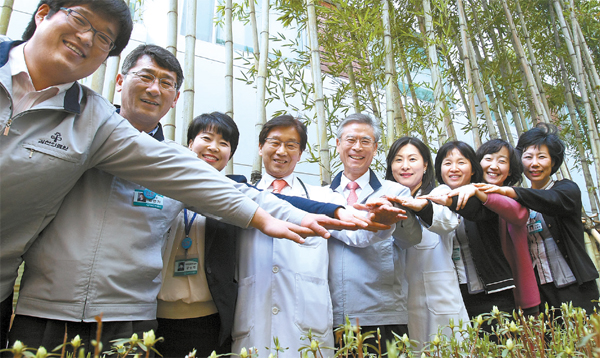CEO-labor cooperation led hospital to success

Kim Young-il (center), president of Gimcheon Medical Center, has led the provincial-government-run hospital successfully, standing out among other facilities that have been hemorrhaging funds. By Gong Jeong-sik
Amid the spate of money-losing institutes, a few well-managed public medical centers stand out.
Gimcheon Medical Center in North Gyeongsang was once also bleeding cash, suffering losses in consecutive years.
Having been turned into a provincial-government-run body in 1983, the medical center incurred 22.4 billion won ($19.7 million) in losses over 24 years and failed to provide payment of 1.7 billion won to its employees.
Demoralized employees became hostile to the sick that visited the hospital, leading to a further decline in the number of patients.
But things began to change in 2009, when Kim Young-il, a dentist and formal vice governor of state affairs, became the president of the medical facility.
The 59-year-old head brought a cot into his office to stay at the hospital day and night. At night, he cheered up people on night duty, and in the morning he baked bread for employees coming to the center.
He constantly discussed with the staff at all levels about ways to better manage the hospital and concluded that they should first change the old medical equipment and beds.
“It’s important to discuss how to better manage a hospital between the president and staff,” said Kim.
“We first set a goal that we seek to achieve and then focus on implementing things that we agree upon. The process accelerates the turnaround,” he said.
The employees were skeptical at first, believing his intention was to run for governorship next year.
But Kim’s sincere endeavor finally won over the staff and they united to find a way to improve the hospital.
The workers voluntarily turned in 5-15 percent of their wages. The president expressed his gratitude by returning 50 percent of his salary.
With a more sanitized facility and kinder staff, the medical center began attracting patients in droves.
The number of patients increased from 180,000 in 2008 to 330,000 last year, swinging to the black for the first time in history.
“Doctors and nurses are really kind. Their care really eases the pain,” said Yoo Gye-sun, 75, who was hospitalized at the Gimcheon hospital.
“It’s really different from when I came here years ago,” she said.
It increased the number of beds and hired 100 more workers, having become the only profit-generating public hospital.
The Gimcheon Medical Center is not alone in successfully transforming itself.
Masan Medical Center was once under more miserable, desperate circumstances. The South Gyeongsang Provincial Government temporality halted operations of the hospital for incurring 1.5 billion won in losses.
The provincial government entrusted the management of the Masan hospital to Gyeongsang National University Hospital, which led the restructure of the cash-strapped institute.
The university hospital sought a way out in treatments targeting the elderly, such as knee joint surgery and rehabilitation therapy.
The two hospitals also share human resources and jointly operated some surgical facilities.
“As we share human and other resources, people might expect the Masan Medical Center to offer university hospital-level services. That’s partly why more and more people come to the Masan center,” said Jang Se-ho, the president of Gyeongsang National University Hospital.
By Song Yee-ho [ejpark@joongang.co.kr]










with the Korea JoongAng Daily
To write comments, please log in to one of the accounts.
Standards Board Policy (0/250자)